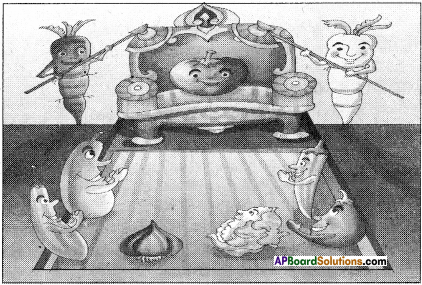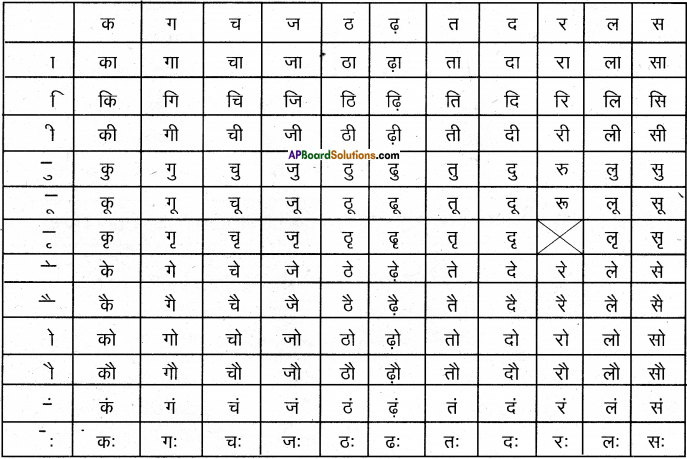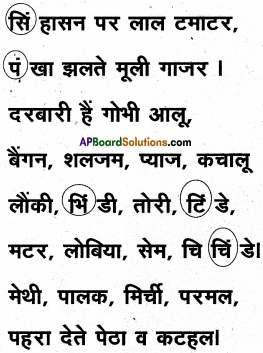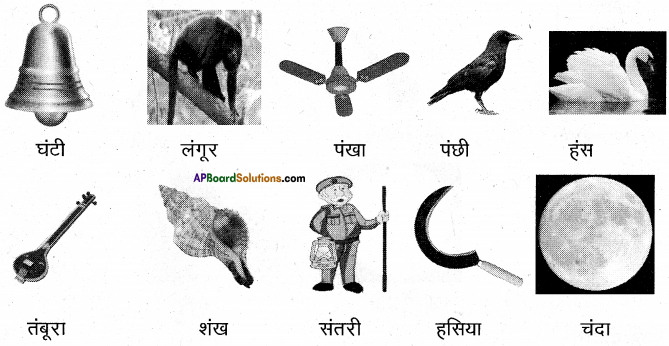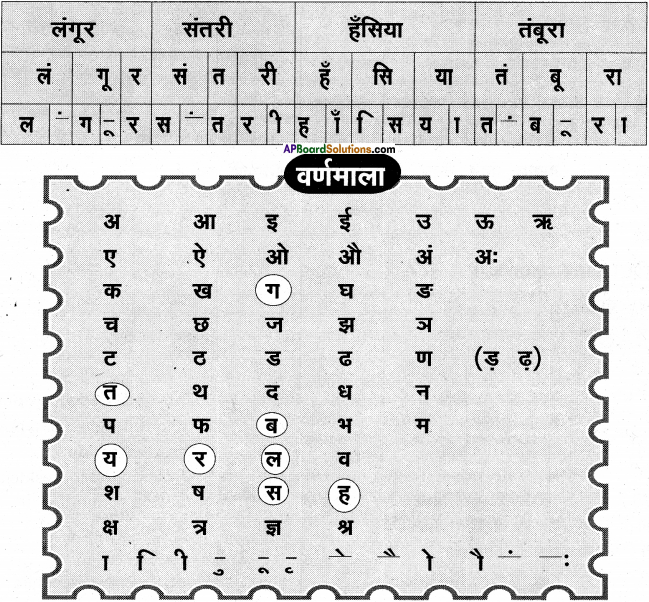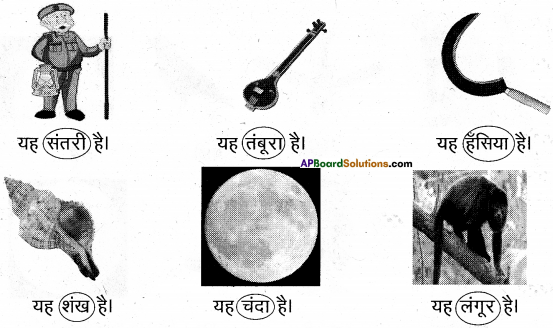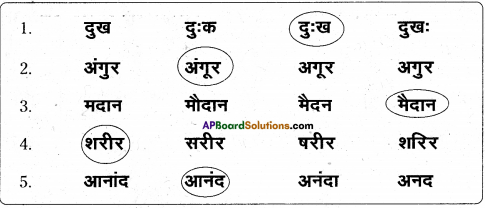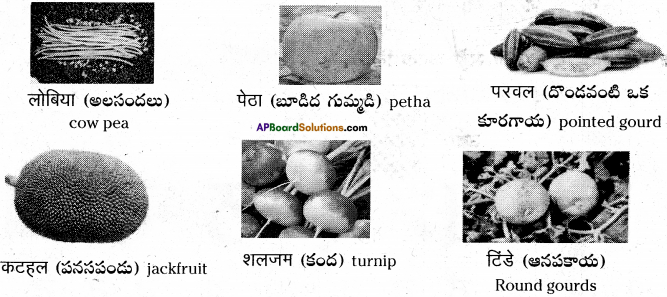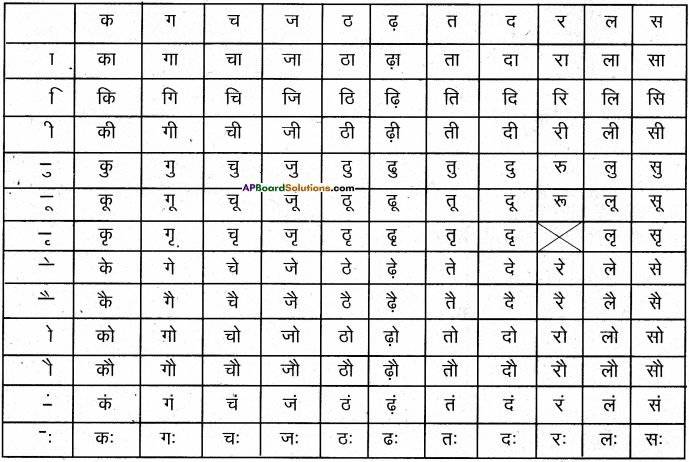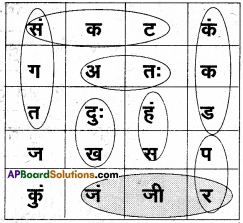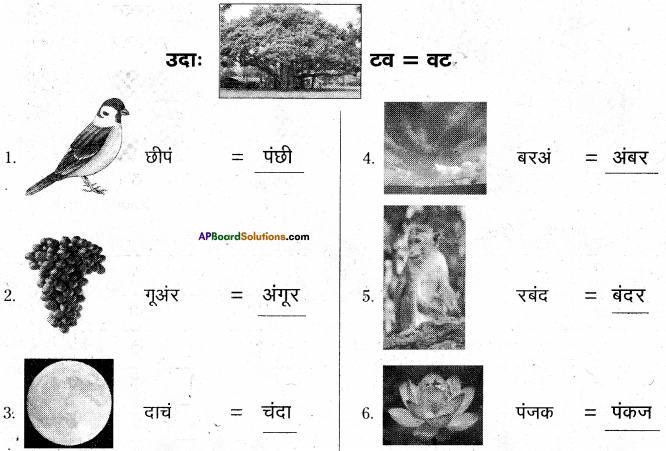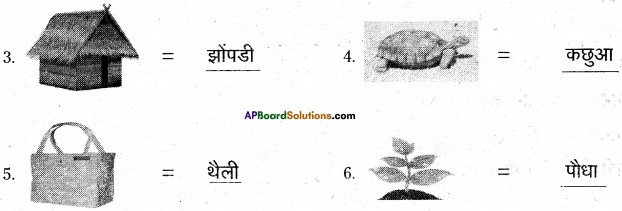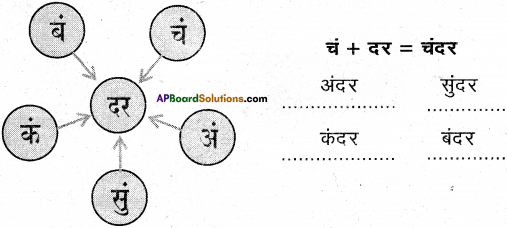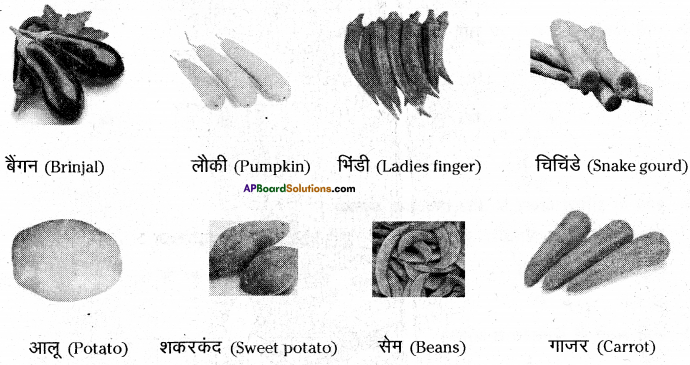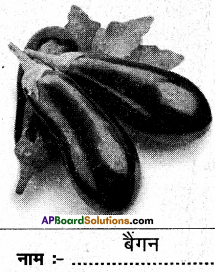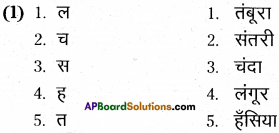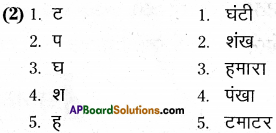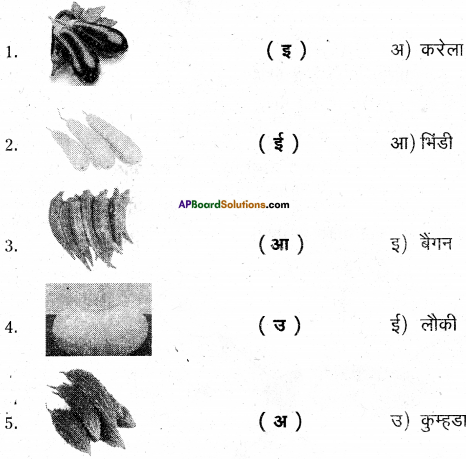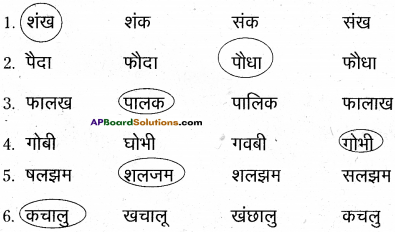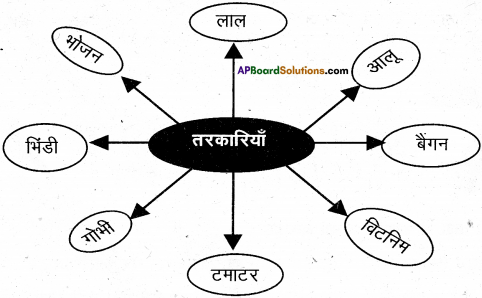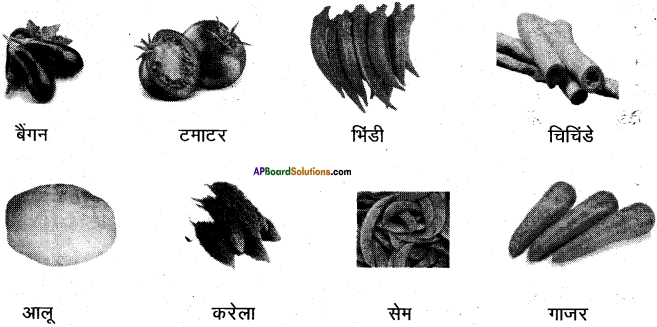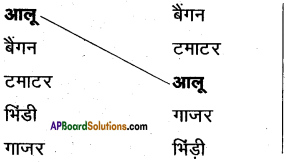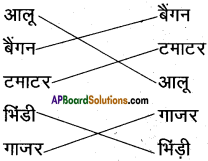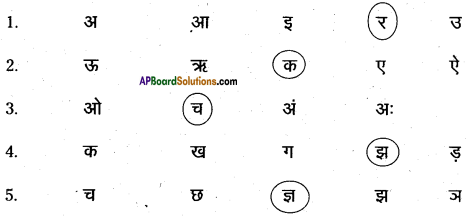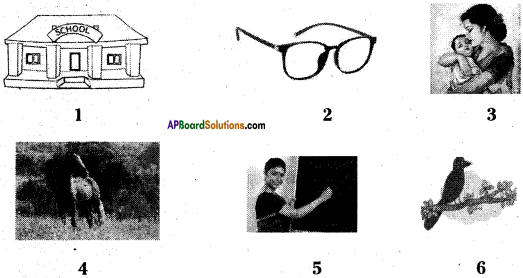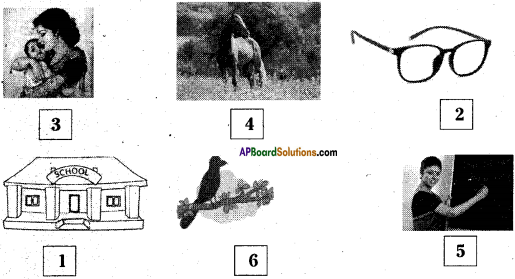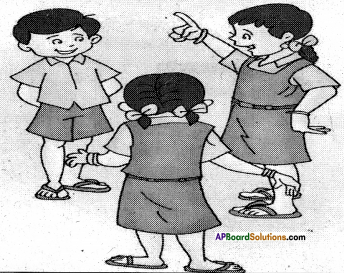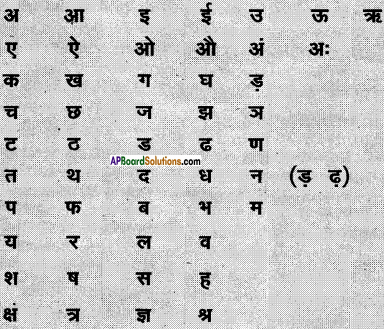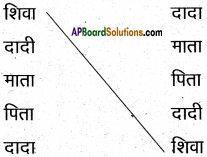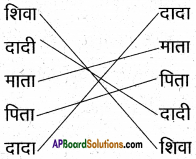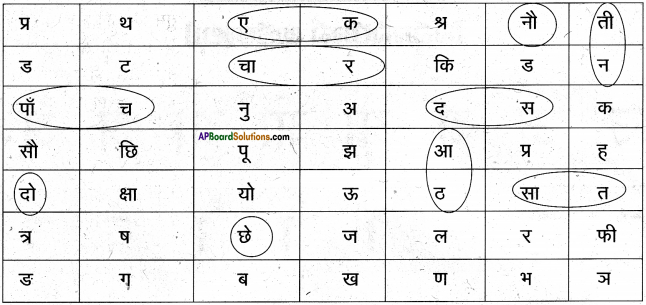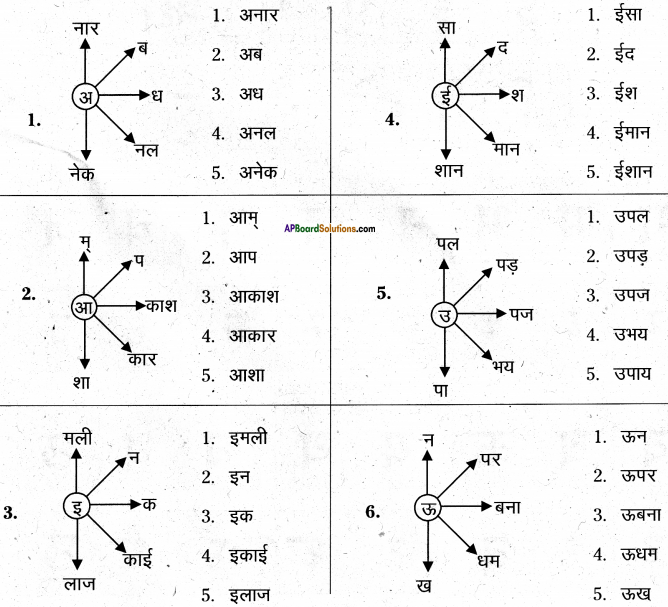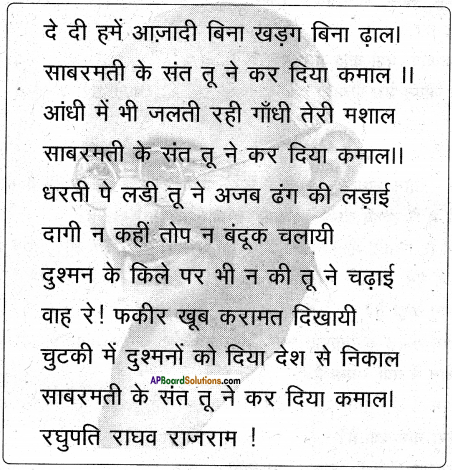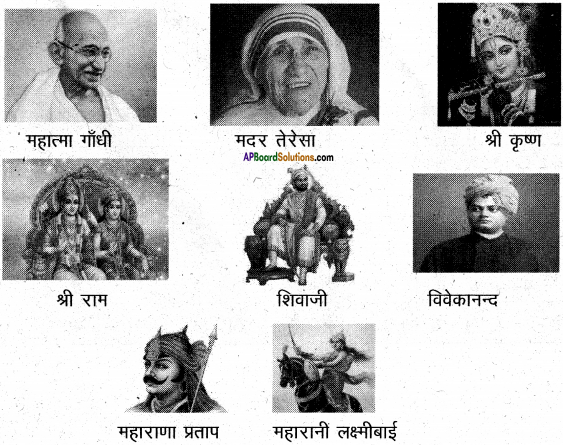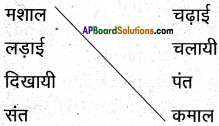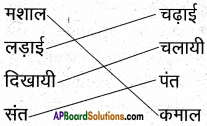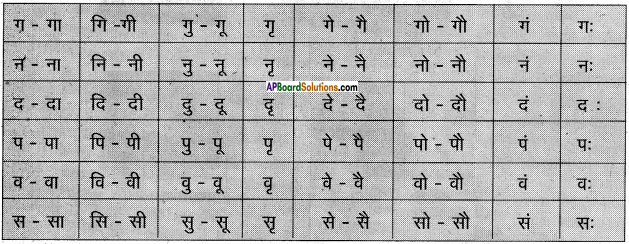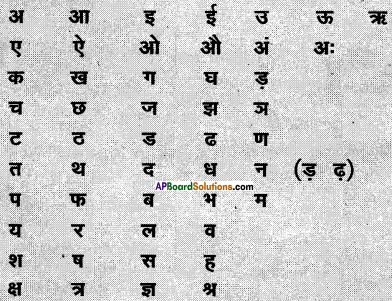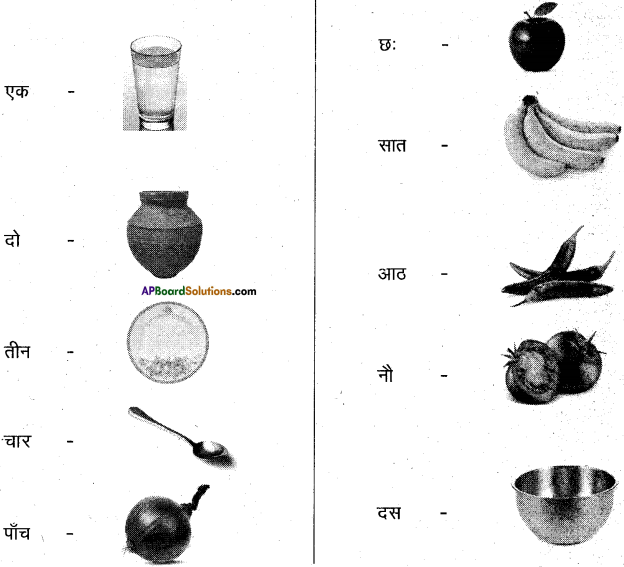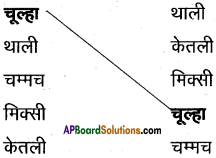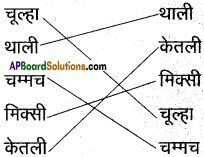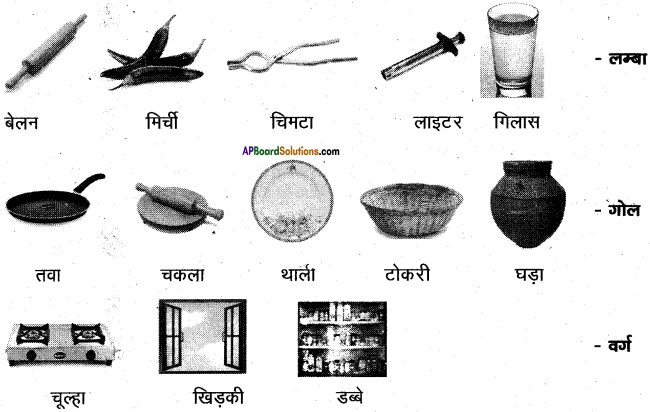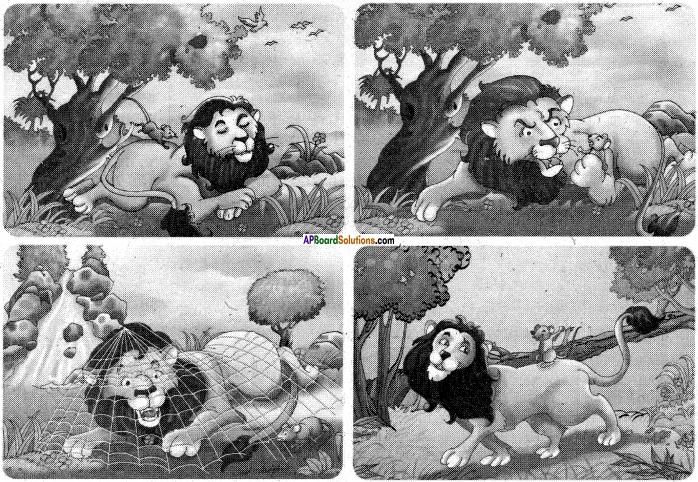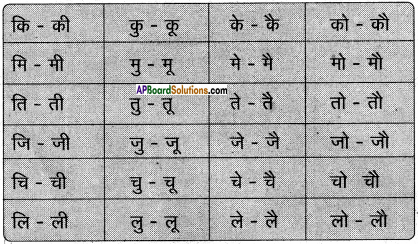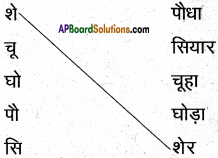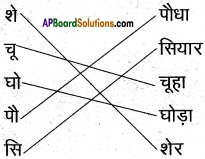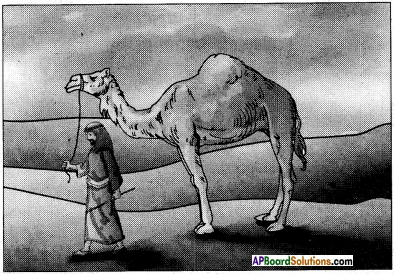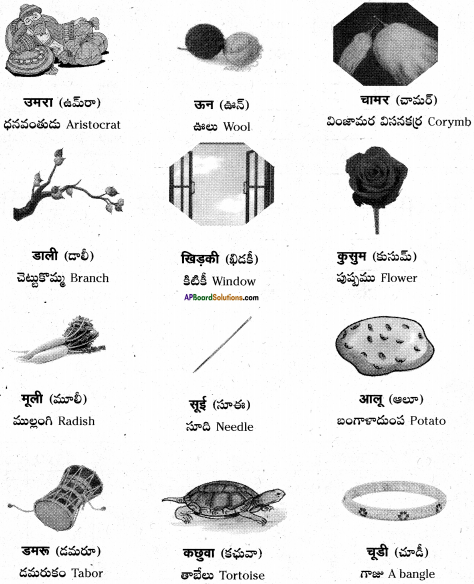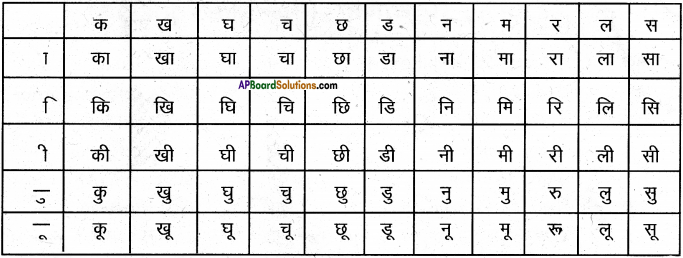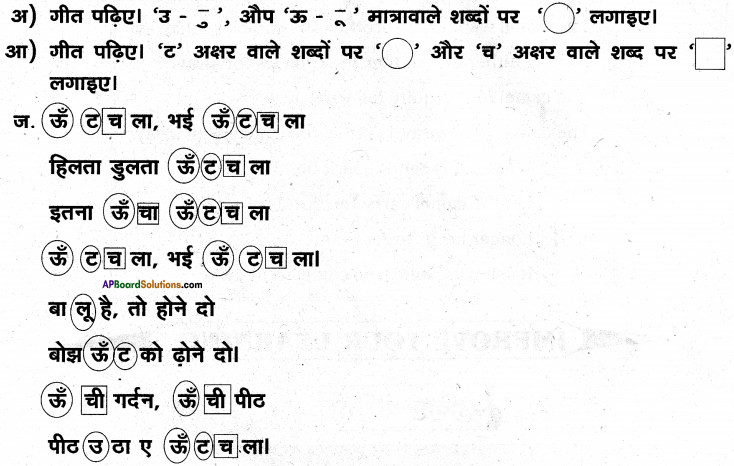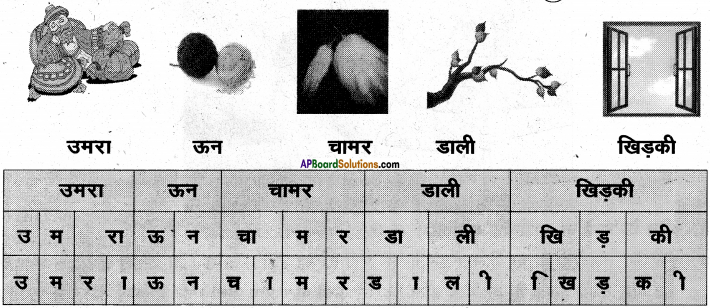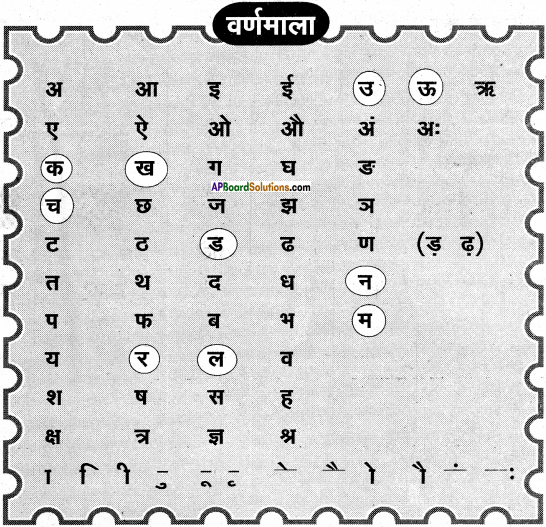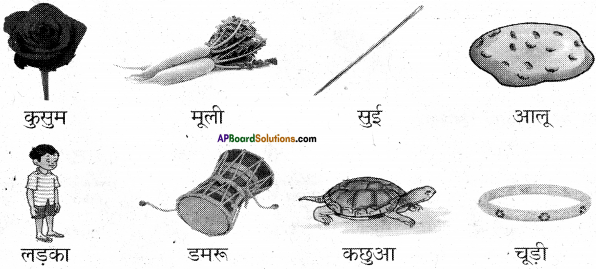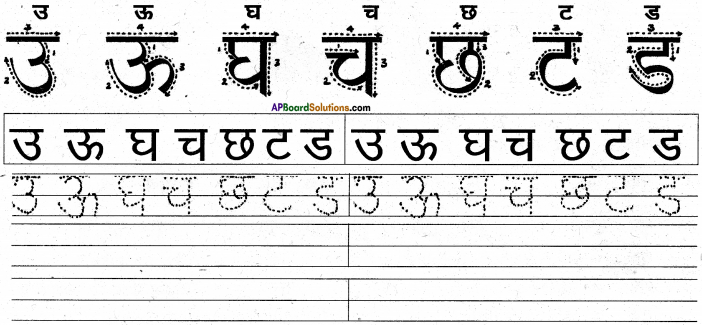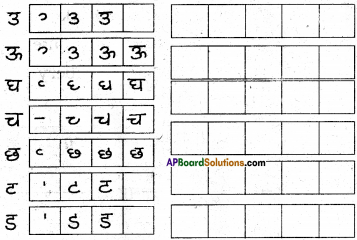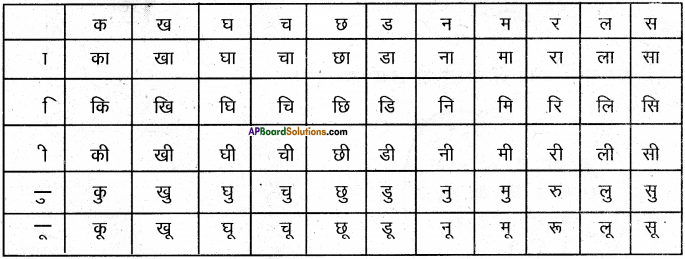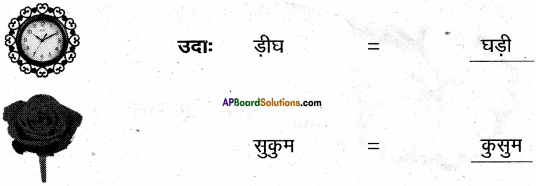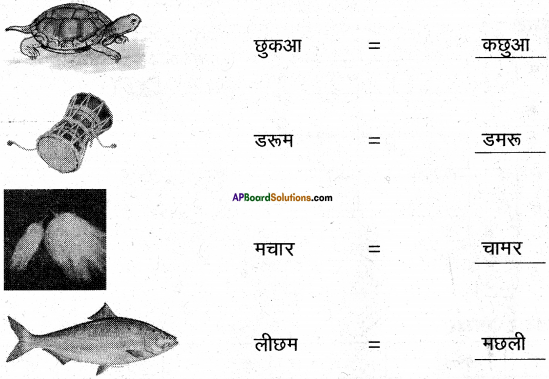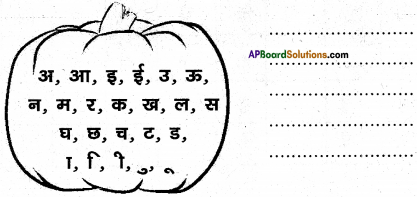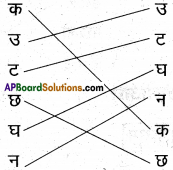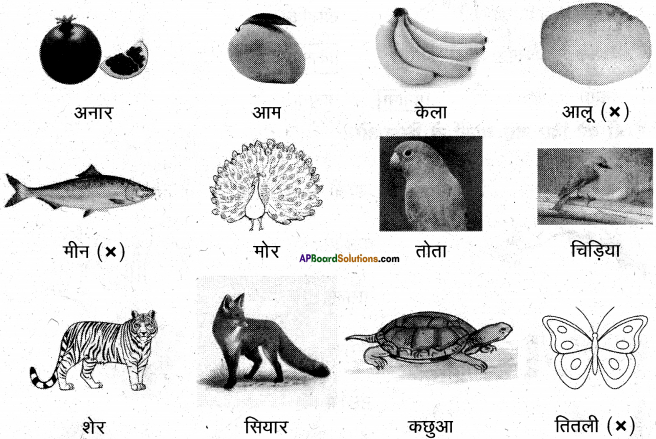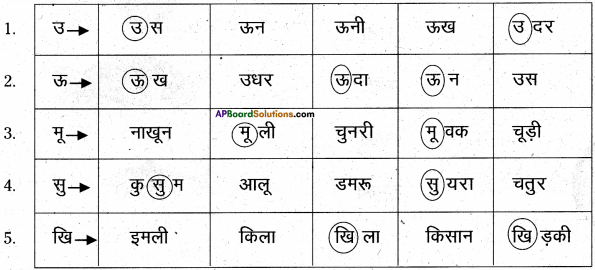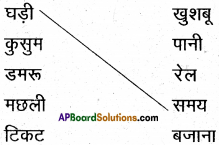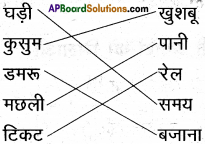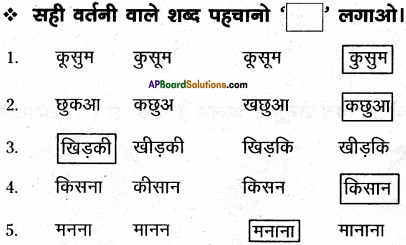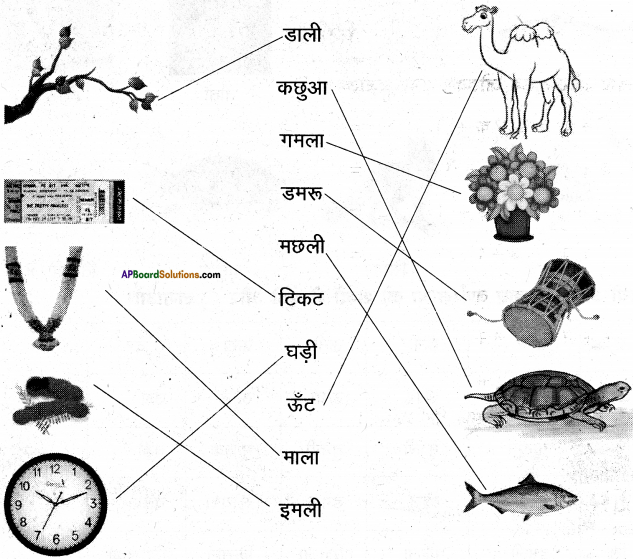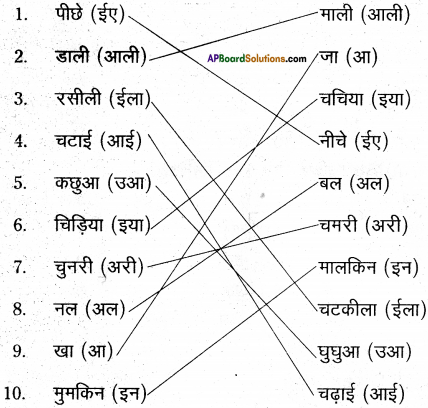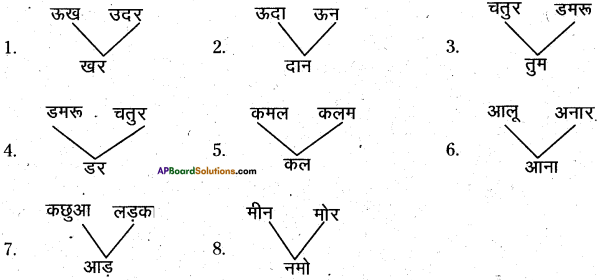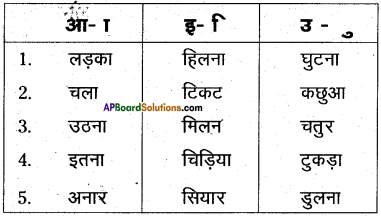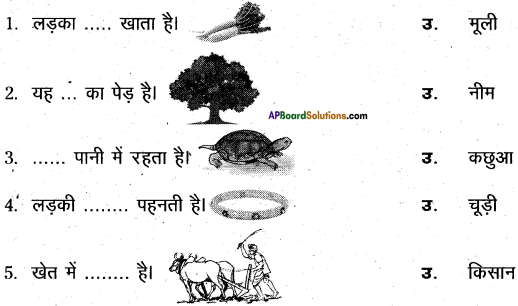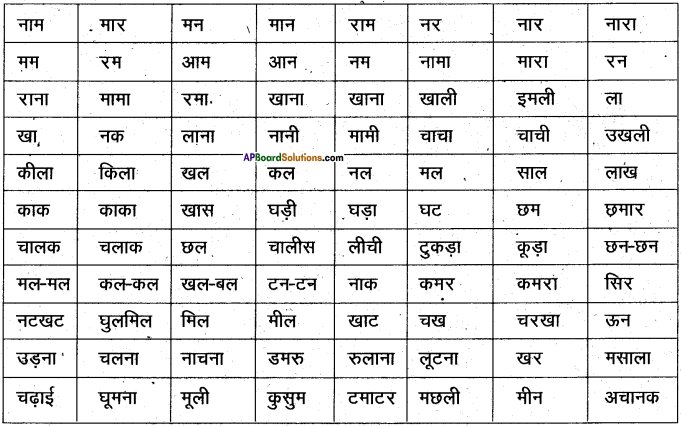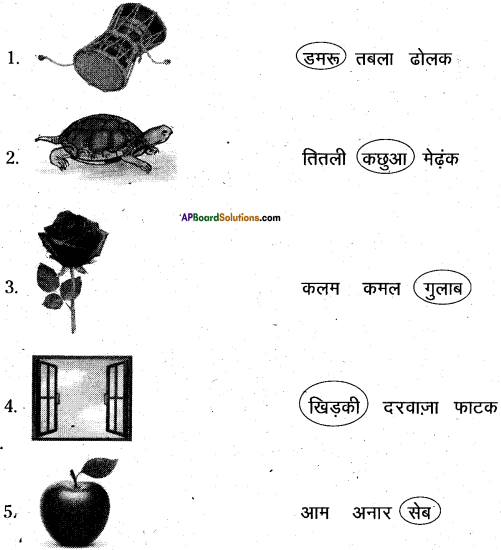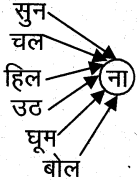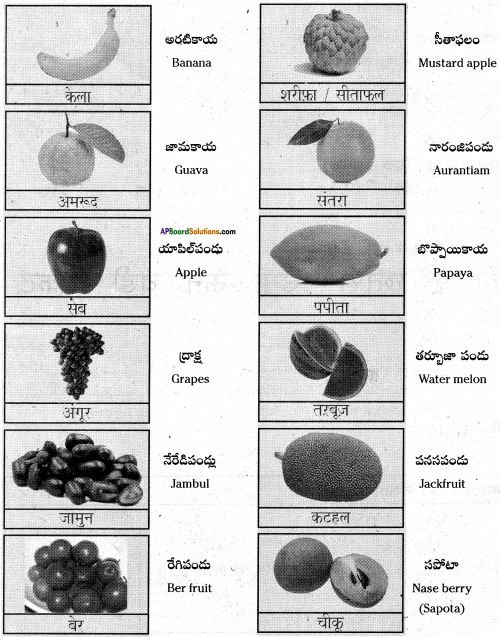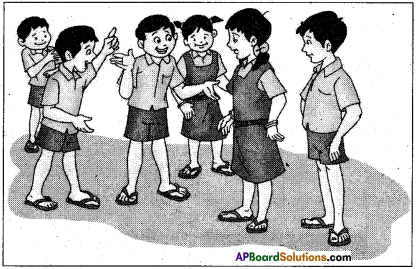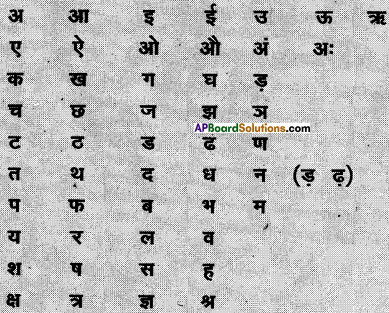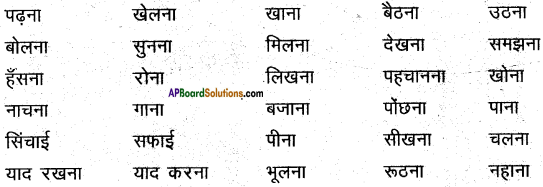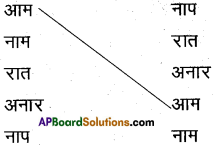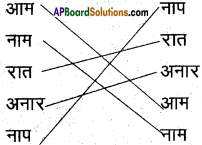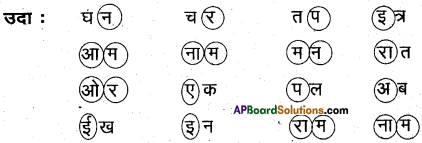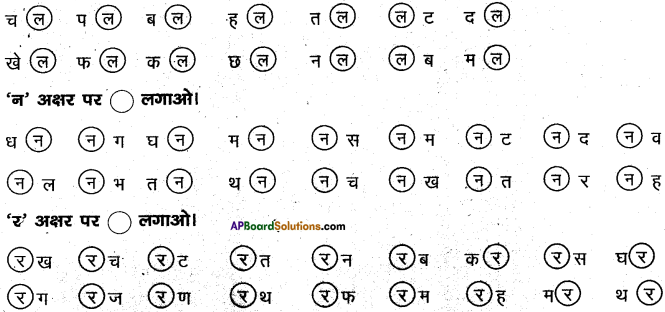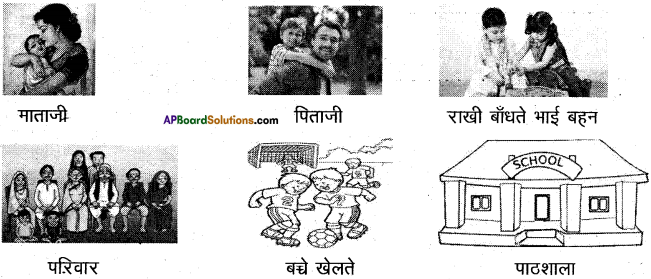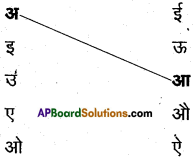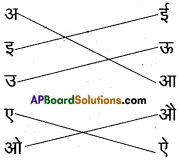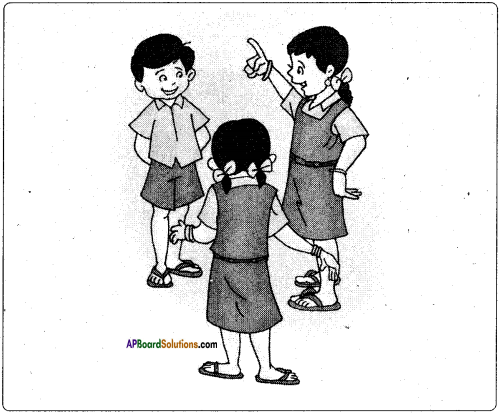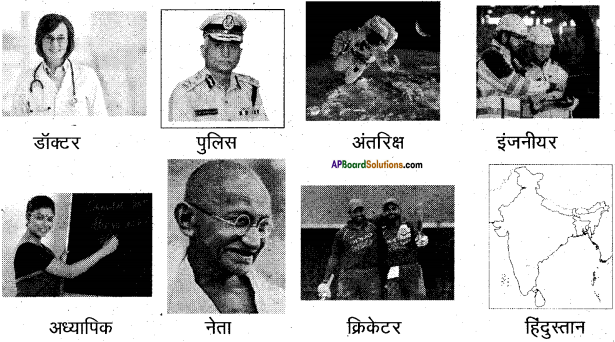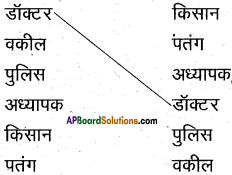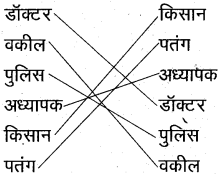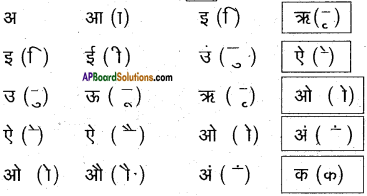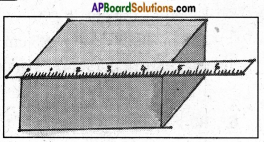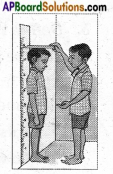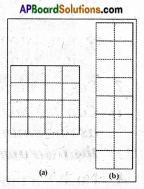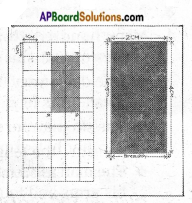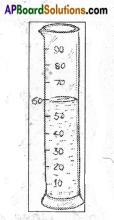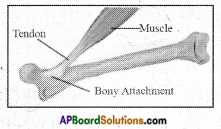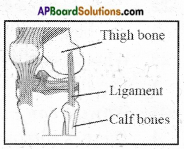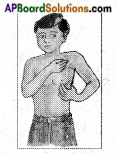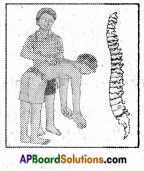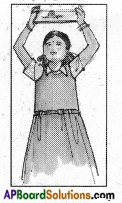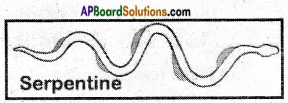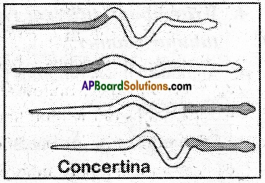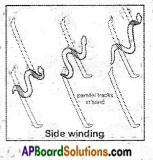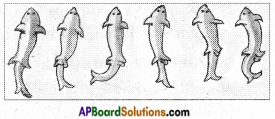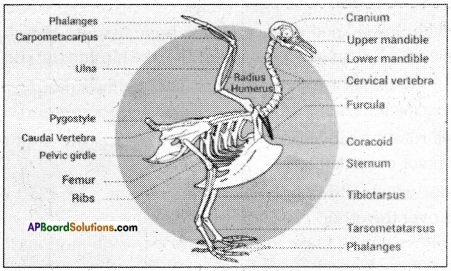AP State Syllabus AP Board 6th Class Hindi Textbook Solutions Chapter 9 जन्म दिन Textbook Questions and Answers.
AP State Syllabus 6th Class Hindi Solutions Chapter 9 जन्म दिन
6th Class Hindi Chapter 9 जन्म दिन Textbook Questions and Answers
Improve Your Learning
सुनिए-बोलिए
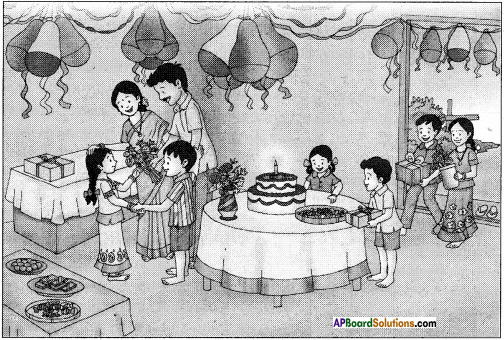
प्रश्न 1.
जन्मदिन के अवसर पर क्या – क्या उपहार मिलते हैं? (జన్మదినమును పురస్కరించుకొని ఏఏ కానుకలు లభిస్తాయి?)
उत्तर:
जन्मदिन के अवसर पर कई उपहार मिलते हैं – जैसे किताब, कलम, मिठाइयाँ, तरह – तरह के खिलौने और नये – नये कपडे आदि।
प्रश्न 2.
आप अपना जन्म दिन कब मनाते हैं? (మీరు మీ పుట్టిన రోజును ఎప్పుడు జరుపుకుంటారు?)
उत्तर:
मैं अपना जन्मदिन 14 नवंबर को मनाता हूँ।
![]()
प्रश्न 3.
इस पाठ में पर्यावरण संरक्षण संबंधी नारा क्या है? (ఈ పాఠంలో పర్యావరణ సంరక్షణకు సంబంధంచిన నినాదం ఏమిటి?)
उत्तर:
इस पाठ में पर्यावरण संबंधि नरा है – “पौधे लगाएँ – धरीत बचाएँ।
शिक्षण बिंदु
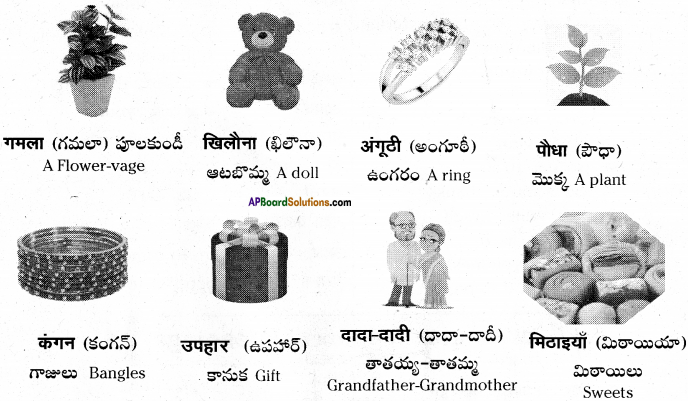
शब्दर्थ (అర్థములు) (Meanings)
जन्म = పుట్టుక, birth
दिन = రోజు, day
जन्म दिन = పుట్టినరోజు, birthday
बेटी = కుమార్తె, daughter
बहुत-बहुत = చాలా చాలా, many-many
बधाइयाँ = శుభాకాంక్షలు, wishes
मामा = మామయ్య, maternal uncle
मामी = అత్తయ్య, maternal aunty
हम = మేము, we
तुम्हारे लिए = నీ కోసం , for you, yourself
कहानियाँ = కథలు, stories
किताबों = పుస్తకములు, books
लाये = తెచ్చితిమి, brought
चाचा = పినతండ్రి, paternal uncle
चाची = పినతల్లి, paternal aunty
बिटिया = కుమార్తె, daughter
नया = కొత్త, new
कपडे = బట్టలు, dress
बुआ (फूफी) = మేనత్త, father’s sister
फूफा = మేనత్త భర్త, father’s sisters’s husband
![]()
खिलौने = ఆటబొమ్మలు, playing toys
पसंद = ఇష్టం, like
गुडया = చిన్నపిల్లలు ఆడుకునే కీలుబొమ్మ, child’s puppet
बोलना = మాట్లాడుట, to talk
बोलनेवाली गुडिया = మాట్లాడు బొమ్మ, talking doll
हमारा = మా యొక్క, ourself
तरफ = వైపు, side
मौसा = బాబాయి, uncle
मौसी = పెద్దమ్మ, పిన్ని, aunt
नाना = అమ్మానాన్న, maternal grand father
नानी = అమ్మఅమ్మ, అమ్మమ్మ, maternal grandmother
ओर = వైపు, towards, side
फल = పండ్లు, fruits
फूल = పూలు, flowers
आप = తమర, your
सभी = అందరూ, to all
धन्यवाद = ధన్యవాదములు, thanks
मुझे = నాకు, mine, myself
लाडली = ప్రియమైన, dear
नाज़ = గర్వము, proudness
पर = మీద, పైన, కానీ, on, but
भला = మంచిది, good
अलग = వేరొక, another
ढंग = పద్దతి, thing
मनाना = జరుపుకొనుట, celebrate
चाह = కోరిక, desire
हर = ప్రతి, every
पौधा = మొక్క, plant
आज = ఈ రోజు, today
उसका = అతని యొక్క, ఆమె యొక్క, him self, herself
इसलिए = అందువలన, thats why
आपका = తమయొక్క, your’s
पाठशाला = పాఠశాల, బడి, school
हाँ = అవును, yes
धरती = భూమి, earth
रक्षा कवच = రక్షణ కవచము, guard
आओ = రా, to come
बचाना = రక్షించుట, to save
अन्य शब्द (అర్థములు) (Meanings)
चित्रा = చిత్రా, a name of a girl
बधाई = శుభకాంక్షలు, wishess
किताब = పుస్తకం, a book
कहानी = కథ, story
खिलौना = అటబొమ్మా, doll
गुडिया = చిన్న పిల్లలు ఆడుకొను కీలుబొమ్మ, child’s puppet (or) doll
चीज = వస్తువు, thing
खरीद = కొను, to buy
लाडली = గారాబం, dear
नाज = గర్వము, proudness
भला = మంచిది, good
ढंग = పద్ధతి, రీతి, thing, kind
व्याकरणांश (వ్యాకరణాంశము)
विशेषण : संज्ञा या सर्वनाम की विशेषता बतलानेवाले शब्द विशेषण कहलाते हैं ।
(నామవాచకములు మరియు సర్వనామముల యొక్క గుణములను తెలియచేయు శబ్దములు విశేషణములనబడును.)
उदा :
नया = క్రొత్త
नीला = నీలిరంగు
बडा = పెద్ద
मीठा = తియ్యని
काली = నల్లని
खट्टा = పుల్లని
का, के, की = avs, of
का పుంలింగ ఏకవచనమునకు ముందు, के పుంలింగ బహువచనమునకు ముందు, की ఉభయ వచనములకు ముందుగా వచ్చును.
గమనిక : ఈ का, के, की లు रा, रे, री లుగా మారును.
उदा:
मैं + का = मेरा – నా యొక్క
तुम + का = तुम्हारा – మీ యొక్క
हम + का = हमारा – మన యొక్క, మా యొక్క
वह + का = उसका – అతని యొక్క, ఆమె యొక్క
यह + का = इसका – ఇతని యొక్క, ఈమె యొక్క
वे + का = उनका – వారి యొక్క
ये + का = इनका – వీరి యొక్క
कौन + का = किसका – ఎవని యొక్క
किनका – ఎవరి యొక్క
जो + का = जिसका = ఎవనిదైతే, जिनका = ఎవరిదైతే
![]()
रिश्तेदार (బంధువులు) (Relatives)
माँ – बाप తల్లి – తండ్రి – Mother – father
सास – ससुर అత్త – మామ – Aunt – Uncle
नाना – नानी తాత – అమ్మమ్మ – Meternal Grandfather, Maternal Grand mother
दादा – दादी తాత – నాన్నమ్మ – Grand father – Grand mother
चाचा – चाची బాబాయి – పిన్ని – Uncle – Aunt
ताऊ – ताई పెద్దనాన్న – పెద్దమ్మ – Uncle – Aunt
मामा – मामी మామాయ్య – అత్తయ్య – Uncle – Aunt
देवर – दवरानी మరిది – తోడికోడలు – Brother in low – Co-daughter in law
वार्तालाप
माँ : चित्रा बेटी ! जन्मदिन की बहुत – बहुत बधाई हो।
मामा – मामी : चित्रा, ये लो ! हम तम्हारे लिए कहानियों की किताबें लाये हैं।
चाचा – चाची : बिटिया ! ये लो, नये कपड़े।
बुआ-फूफा : चित्रा तुमको खिलौने पसंद है ना, हम बोलनेवाली गुड़िया लाये हैं।
मौसा-मौसी : हमारी तरफ़ से ये पैसे लो, मन पसंद चीज़ खरीद लो।
नाना – नानी : यह लो ! हमारी ओर से फल – फूल।
चित्रा : आप सभी को धन्यवाद।
पिताजी : मुझे अपनी लाड़ली पर नाज़ है।
मामी : वह भला क्यों?
माँ : हमारी बेटी अपने जन्मदिन को अलग ढंग से मनाना चाहती है।
दादा – दादी : हमारी चित्रा हर जन्मदिन पर पौधे लगाना चाहती है।
पिताजी : आज उसका दसवाँ जन्मदिन है। इसलिए वह अपनी पाठशाल में दस पौधे लगाना चाहती है।
चित्रा : हाँ मामी, वृक्ष धरती के रक्षा कवच हैं।
आओ …… “पौधे लगाएँ …. धरती बचाएँ।”
సంభాషణ
అమ్మ : అమ్మాయి చిత్రా ! పుట్టిన రోజు శుభాకాంక్షలు.
మామయ్య అత్తయ్య : చిత్రా, ఇవిగో తీసుకో ! మేము నీ కోసం కథల పుస్తకాలు తెచ్చాము.
బాబాయి పిన్ని : అమ్మాయి ! ఇవిగో ఇవి తీసుకో, నూతన వస్త్రాలు.
పినతండ్రి-పిన్ని : చిత్రా నీకు ఆట బొమ్మలంటే ఇష్టం కదా ! ఇదిగో మాట్లాడే బొమ్మను తెచ్చాము.
మామ అత్త : మా తరఫున ఈ డబ్బులు తీసుకో, మనస్సుకు ఇష్టం వచ్చినవి కొనుక్కో.
తాతయ్య-అమ్మమ్మ : ఇవిగో ఇవి తీసుకో మా తరఫున పండ్లు – పూలు.
చిత్ర : మీ అందరికీ ధన్యవాదములు.
నాన్నగారు : నాకు నా కుమార్తె పట్ల చాలా గర్వంగా ఉన్నది.
అత్తయ్య : మంచిదే, ఎందుకు?
అమ్మ : మా అమ్మాయి తన పుట్టిన రోజును మరోలా చేసుకోవాలని అనుకుంటోంది.
తాతయ్య-నానమ్మ : మా చిత్రా ప్రతి పుట్టిన రోజున మొక్కలు నాటాలని అనుకుంటోంది.
నాన్నగారు : ఈ రోజు చిత్ర 10వ పుట్టినరోజు. అందుకని చిత్ర ఈ రోజున తన పాఠశాలలో 10 మొక్కలను నాటాలని అనుకుంటోంది.
చిత్ర : అవును అత్తయ్య, చెట్లు భూమి రక్షణ కవచాలు.
రండి … “మొక్కలు నాటండి … భూమిని రక్షించండి.”
Conversation in English
Mother : Dear Chitra! Wish you a happy birthday!
Maternal Uncle Maternal Aunt : Chitra, take these. We brought story books for you.
Paternal Uncle Paternal Aunt : Dear one! Here these are take these new clothes.
Father’s SisterHer Husband : Chitra, you are fond of toys, aren’t you? Here it is, we brought a talking doll for your.
Mother’s SisterHer Husband : Take this money on our behalf, Buy whatever you like most
Maternal Grandfather Maternal Grandmother : Here they are, take fruits and flowers on our behalf.
Chitra : I am very grateful to you all.
Father : I am very pound of my daughter.
Maternal Aunt : Good, but why?
Mother : Our daughter would like to celebrate her birthday in a different way.
Grandfather Grandmother : Our grandchild Chitra wants to plant trees on the occasion of her birthday every day.
Father : Today it is Chitra’s tenth birthday. That’s why she wants to plant ten trees in her school.
Chitra : Yes aunt! Trees are the guards of our earth. Come plant trees – save the earth.
पढ़िए
अ) चित्र देखिए। शब्द पढ़िए।
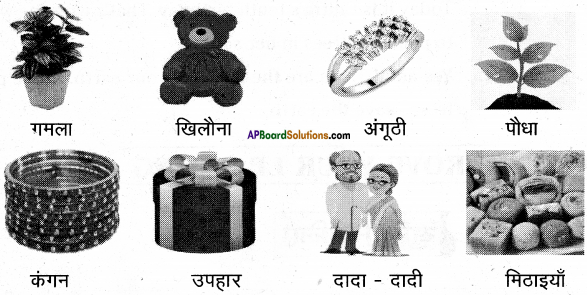
आ) पढ़िए।

लिरिवाए
अ) खाली जगह भरिए।

आ) चित्र के आधार पर वर्तनी सही करके लिखिए।

इ) मात्राओं के अनुसार तालिक भरिए।
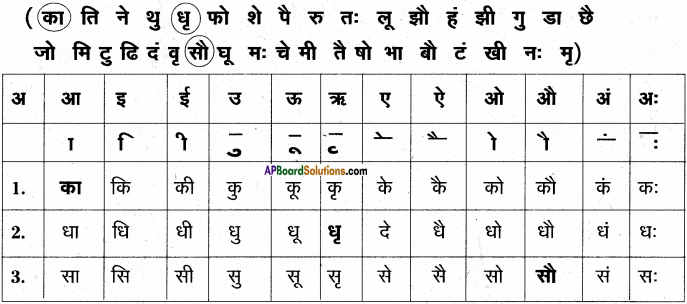
ई) गिनती का गीत
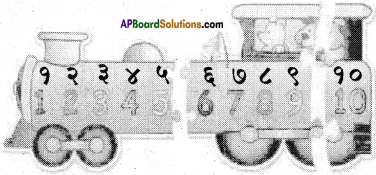
एक दो तीन चार,
बोलो कब है रविवार।
आज शनि कल है इतवार,
मौज करें साथ है परिवार।
पाँच छह सात आठ,
पढ़ता रहूँ सारे पाठ।
नौ हैं रस, अवतार है दस,
अब गिनती हई है बस
1. एक
2. दो
3. तीन
4. चार
5. पाँच
6. छह
7. सात
8. आट
9. नौ
10. दस
शब्दार्थ (అర్థములు) (Meanings)
बोलो = చెప్పు, to tell
रविवार = ఆదివారం, sunday
कल = నిన్న, రేపు, yesterday
साथ = తో, with
पढ़ना = చదువుట, reading
पाठ = పాఠం, lesson
गिनती = లెక్క, count
मौज = ఉత్సాహం, సంతోషం, అల, wave, happiness
कब = ఎప్పుడు, when
आज = ఈ రోజు, today
इतवार = ఆదివారం, sunday
परिवार = కుటుంబం, family
सारा = మొత్తం, total
अब = ఇప్పుడు, now
अवतार = అవతారములు, incornations
उ) प्रश्नः
1. मामा – मामी से क्या उपहार मिले हैं? (మామయ్య – అత్తయ్యల నుండి ఏ కానుకలు లభించినవి?)
उत्तर:
मामा – मामी से कहानियों की किताबें उपहार रूप में मिले हैं।
2. नाना – नानी से क्या उपहार मिले हैं? (తాతయ్య – అమ్మమ్మ నుండి ఏ కానుకలు లభించినవి?)
उत्तर:
नाना – नानी से फल और फूल उपहार के रूप में मिले हैं।
3. चित्रा अपने जन्मदिन पर क्या करना चाहती है? (చిత్ర తన పుట్టినరోజున ఏమి చేయాలని అనుకుంటోంది?)
उत्तर:
चित्रा अपने जन्मदिन पर अपनी पाठशाला में दस पौधे लगाना चाहती है।
4. पौधे लगाने से क्या लाभ है? (మొక్కలు నాటడం వలన కలిగే లాభాలు ఏమి?)
उत्तर:
- पौधे लगाने से प्रकृति की शोभा बढ़ती है।
- पौधे बढ़कर पेड़ बनेंगे।
- पेड हमें फल – फूल पत्ते देते हैं।
- उनसे पर्यावरण ठीक रहेगा।
- पेड़ – पौधे मेघों को आकर्षित करके वर्षा देते हैं।
सृजनात्मकता
पेड़ – पौधों के चित्र संग्रहित करके नोटबुक में चिपकाइए।
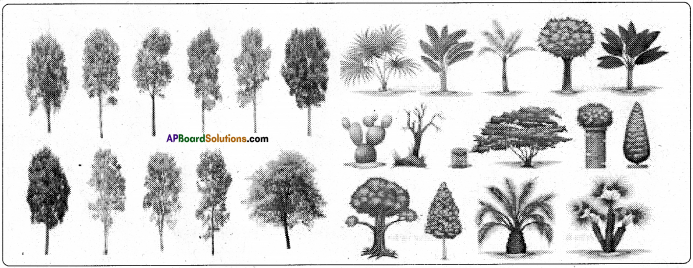
रंगों के नाम
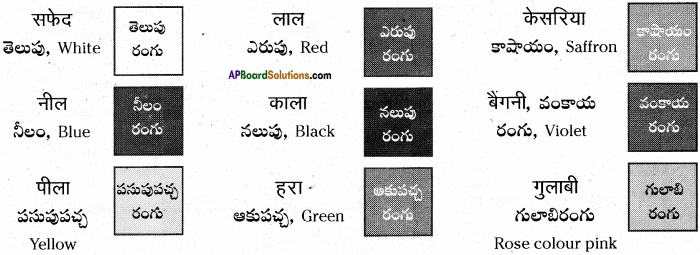
अध्यापक चित्रों को / वस्तुओं को दिखाते हुए कुछ प्रश्न पूछेगे, और छात्र उत्तर देंगे।
(ఉపాధ్యాయులు చిత్రం / వస్తువులను చూపిస్తూ పిల్లల్ని కొన్ని ప్రశ్నలు అడిగెదరు, పిల్లలు వాటికి సమాధానాలు చెప్పెదరు.)
1. यह गमला है। – ఇది పూల కుండి. – It is a flower vage.
2. वह खिलौना है। – అది ఆటబొమ్మ – That is a doll.
3. यह अंगूठी है। – ఇది ఉంగరం – It is a ring
4. ये कंगन हैं। – ఇవి గాజులు – These are bracelets.
5. वे पौधे हैं। – అవి మొక్కలు. – Those are plants.
6. ये उपहार है। – అవి కానుకలు. – These are gifts.
7. वे मिठाइयाँ हैं। – అవి మిఠాయిలు. – Those are sweets.
8. दादा और दादी खडे हुए हैं। – తాతయ్య, నానమ్మ నిలబడియుండిరి. – Grand father and Grand mother are standing
9. डाली पर कोयल है। – కొమ్మ మీద కోకిల ఉన్నది. – Ther is a cuckoo on a branch of the tree.
![]()
नीचे दिये गये अक्षरों से शब्दों को मिलाइए।
1. कं – 1. इयाँ
2. खि – 2. दा
3. दा – 3. हार
4. अप – 4. गान
5. मिठा – 5. लौना
6. ग – 6. धा
7. सफे – 7. मला
8. पौ – गूर
9. अं – 9. दे
10. अं – 10. गूठी
उत्तर:
1. कंगन
2. खिलौना
3. दादा
4. उपहार
5. मिटाइयाँ
6. गमला
7. सफेद
8. पौधा
9. अंगूठी
10. अंगूर
नीचे दिये गये अक्षरों को सही ढंग से लिखकर शब्द बनाइए।

सही चित्र से जोडिए।
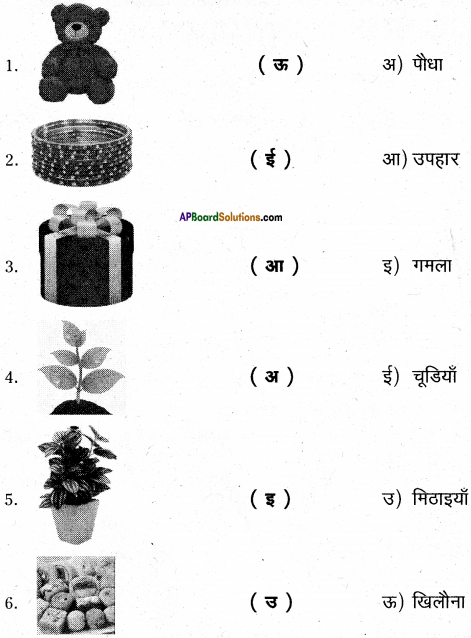
निम्न लिखित शब्दों के विलोम शब्द लिखिए।
माँ × बाप
बहुत × कम
पसंद × नापसंद
सभी × कुछ
धरती × आकश
जन्म × मरण
लेना × देना
खरीदना × बेचना
आज × कल
दिन × रात
नया × पुराण
सब × कुछ
रक्षा × भक्षा
निम्न लिखित शब्दों के लिंग बदलकर लिखिए।
मामा – मामी
पुत्र – पुत्री
बुआ – फूफा
माता – पिता
माँ – बाप
भाई – बहन
मौसा – मौसी
दादा – दादी
बेटा – बेटी
चाचा – चाची
नाना – नानी
सही शब्दों से रिक्तस्थान भरिए।
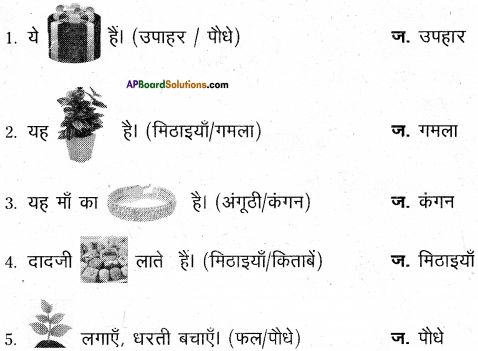
निम्न लिखित प्रश्नों के उत्तर लिखिए।
प्रश्न 1.
चाचा – चाची ने जन्मदिन के उपहार के रूप में चित्रा को क्या दिये? (బాబాయి – చిన్నమ్మ చిత్ర పుట్టినరోజు కానుకగా చిత్రకు ఏమి ఇచ్చిరి?)
उत्तर:
चाचा-चाची ने जन्मदिन के उपहार के रूप में चित्रा को नये कपडे दिये।
प्रश्न 2.
बुआ – फूफा ने चित्रा को जन्मदिन के उपहार के में रूप में क्या दिये? (మేనత్త – మేనత్త భర్త చిత్ర పుట్టినరోజు కానుకగా చిత్రకు ఏమి ఇచ్చిరి?)
उत्तर:
बुआ और फूफ़ा ने चित्रा को जन्मदिन के उपहार के रूप में बोलनेवाली गुडिया दिये।
![]()
प्रश्न 3.
चित्रा के जन्मदिन पर नाना-नानी ने क्या दिये? (చిత్ర పుట్టిన రోజున తాతయ్య – అమ్మమ్మలు ఏమి ఇచ్చిరి?)
उत्तर:
चित्रा को जन्मदिन पर नाना – नानी ने फल और फूल दिये।
प्रश्न 4.
‘जन्मदिन’ पाठ का सारांश लिखिए।
उत्तर:
आज चित्रा का जन्मदिन है। इस अवसर पर चित्रा के मामा और मामी ने उसे कहानियों की किताबें लाये। उसके चाचा – चाची ने चित्रा के लिए नये कपडे लाये। बुआ और फूफ़ा ने बोलनेवाली गुडिया लाये। मौसा और मौसी ने पैसे दिये | नाना – नानी ने उसे फल और फूल दिये हैं। चित्रा अपने जन्मदिन पर हर साल पौधे लगाती है। आज उसका दसवाँ जन्मदिन होने के कारण वह अपनी पाठशाला में दस पौधे लगाना चाहती है।
अध्यापक नीचे दिये गये शब्दों को कहेंगे छात्र इन्हें सुनकर दोहरायेंगे।
(ఉపాధ్యాయులు క్రింది ఇచ్చిన పదాలను చెప్పెదరు. విద్యార్థులు వాటిని విని తిరిగి చెప్పెదరు.)
बाल दिवस – బాలల దినోత్సవం, – Children’s day.
स्वतंत्रता दिवस – స్వాతంత్ర్య దినోత్సవం, – Independence day.
गणतंत्र दिवस – గణతంత్ర దినోత్సవం, – Republic day.
शिक्षक दिवस – ఉపాధ్యాయ దినోత్సవం, – Teacher’s day.
जन्मदिन – పుట్టినరోజు – Birthday
इन्हें समझो। (వీటిని అర్థం చేసుకో.)
यह – है। – ఇది – ఉన్నది. ఇతను – ఉన్నాడు. – It is, / This is / He is / She is
वह – है। – అది – ఉన్నది. అతను – ఉన్నాడు. ఆమె ఉన్నది. – That is / He is / She is
ये – हैं। 56 – వీరు – ఉన్నారు. ఇవి – ఉన్నవి. – These are
वे – हैं। – వారు – ఉన్నారు. అవి – ఉన్నవి. – Those are.
नीचे दिये गये संकेतों के आधार पर चार वाक्य लिखिए।
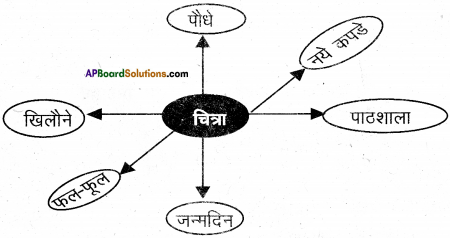
- आज चित्रा का जन्मदिन है।
- चित्रा आज पाठशाल में पौधे लगाना चाहती है।
- माँ – बाप ने उसे नये कपडे दिये।
- जन्मदिन पर उसे फल – फूल, खिलौने आदि उपहार के रूप में मिले।
![]()
उचित शब्दों से रिक्तस्थान भरिए।
(खरीद, बधाई, पौधे, लाड़ली, रक्षा, धन्यवाद)
1. जन्मदिन की बहुत – बहुत …….. हो।
उत्तर:
बधाई
2. मन पसंद चीज ……. लो।
उत्तर:
खरीद
3. आप सभी को ……….. |
उत्तर:
धन्यवाद
4. चित्रा जन्मदिन पर ….:. लगाना चाहती है।
उत्तर:
पौधे
5. वृक्ष धरती के …….. कवच हैं।
उत्तर:
रक्षा
6. मुझे अपनी ……… पर नाज़ है।
उत्तर:
लाड़ली
हिंदी अक्षरों में लिखिए।
1) 41 – एक्तालीस
2) 42 – बयालीस
3) 43 – तैंतालीस
4) 44 – चौंतालीस
5) 45 – पैंतालीस
6) 46 – छियालीस
7) 47 – सैंतालीस
8) 48 – अड़तालीस
9) 49 – उनचास
10) 50 – पचास
शब्द के अंतिम अक्षर से और एक शब्द बनाइए।
1. गमला → लाल → लाठी
2. उपहार → रथ→ थन
3. खिलौना → नानी → नीम
4. कंगन → नथ → थल
5. अंगूठी → ठीक → कान
![]()
निम्न लिखित शब्दों को वाक्यों में प्रयोग कीजिए।
1. जन्मदिन : आज मेरा जन्मदिन है।
2. पौधा : राम पौधा लगाता है।
3. खिलौने : वह खिलौना लाता है।
4. मिठाइयाँ : चित्रा अपने जन्मदिन पर मिठाइयाँ बाँटती है।
5. फल फूल : चित्रा के नाना – नानी ने उसे फल – फूल दिये।
नीचे दिये गये वाक्यों को घटना क्रम के आधार पर पहचानकर रिक्त स्थान में उचित संख्या लिखिए ।
1. चित्रा को चाचा – चाची ने नये कपडे दिये।
उत्तर: 2
2. चित्रा सब को धन्यवाद देदी।
उत्तर: 3
3. जन्मदिन पर चित्रा पौधा लगाती है।
उत्तर: 4
4. आज चित्रा का जन्म दिन है।
उत्तर: 1
वर्तनी की दृष्टि से रेखांकित शब्दों के शुद्ध रूप लिखिए।
1. बहुत – बहुत बदाइयाँ
उत्तर:
बधाइयाँ
2. आप सभी को दनयवाद
उत्तर:
धन्यवाद
3. वह बला क्यों?
उत्तर:
भला
4. पौदे लगाएँ, धरती बचाएँ।
उत्तर:
पौधे
5. हमारी ओर से फल – पूल
उत्तर:
फूल
6. ये लो नये खपढ़े।
उत्तर:
कपडे
रेखांकित शब्दों के अर्थ अपनी मात्रुभाषा या अंग्रेज़ी में लिखिए।
1. चित्रा तुम्हें खिलौने पसंद है न?
उत्तर:
ఇష్టము, like
2. मुझे अपनी लाडली पर नाज है।
उत्तर:
గర్వం, proudness
3. पौधे लगाएँ, धरती बचाएँ।
उत्तर:
భూమి, the earth
4. हम बोलनेवाली गुडिया लाये हैं।
उत्तर:
ఆట బొమ్మలు, toys
5. मन पसंद चीज़ खरीद लो।
उत्तर:
కొను, buy
![]()
शब्दों को सही क्रम में रखकर वाक्य बनाइए।
1. जन्मदिन है चित्रा आज का।
उत्तर:
आज चित्रा का जन्मदिन है।
2. धन्यवाद सभी को आप।
उत्तर:
आप सभी को धन्यवाद।।
3. हम लाये है बोलनेवाली गुडिया।
उत्तर:
हम बोलनेवाली गुड़िया लाये हैं।
4. क्यों भला वह?
उत्तर:
वह भला क्यों?
5. पौधे चाहती है लगाने चिंत्रा
उत्तर:
चित्रा पौधे लगाना चाहती है।
समान उच्चारण वाले शब्दों को जोड़ी बनाइए।

उत्तर:
1. चीज बीज
2. गुडिया बुढ़िया
3. उपहार अपकार
4. कंगन चंदन
5. कोयल कोमल
6. भार धार
डिब्बे में दिये गये अक्षर पढ़िए। रिक्तस्थान भरिए।
(य, उप, याँ, खि, अं)

नीचे दिये गये शब्द पढ़िए, द्वित्वाक्षर वाले शब्दों पर गोला ‘O’ लगाइए। संयुक्ताक्षरवाले शब्दों पर ‘[ ]’ बाक्स लगाइए।

सही शब्दों से रिक्तस्थानों की पूर्ति कीजिए।
(जन्मदिन, कपडे, लाडली, पौधे, धन्यवाद)
1. आप सभी को ………
उत्तर:
धन्यवाद
2. ………. की बहुत – बहुत बधाई।
उत्तर:
जन्मदिन
3. …….. लगाएँ, धरती बचाएँ।
उत्तर:
पौधे
4. ये लो, नये ………
उत्तर:
कपडे
5. मुझे अपनी …… पर नाज है।
उत्तर:
लाडली
![]()
निम्न लिखित वार्तालाप पढ़कर दिये गये प्रश्नों के उत्तर लिखिए।
माँ : चित्रा बेटी ! जन्मदिन की बहुत – बहुत बधाई हो।
मामा – मामी : चित्रा, ये लो ! हम तुम्हारे लिए कहानियों की किताबें लाये हैं।
चाचा – चाची : बिटिया ! ये लो, नये कपड़े।
बुआ-फूफा : चित्रा तुमको खिलौने पसंद है ना, हम बोलनेवाली गुड़िया लाये हैं।
मौसा-मौसी : हमारी तरफ़ से ये पैसे लो, मन पसंद चीज़ खरीद लो।
नाना – नानी : यह लो ! हमारी और से फल – फल।
चित्रा : आप सभी को धन्यवाद।
पिताजी : मुझे अपनी लाड़ली पर नाज़ है।
प्रश्न :
1. चित्रा ने सभी को क्या दिया?
उत्तर:
चित्रा ने सभी को धन्यवाद दिया।
2. आज किस का जन्मदिन है?
उत्तर:
आज चित्रा का जन्मदिन है।
3. चित्रा को नये कपडे कौन दिये?
उत्तर:
चित्रा को नये कपडे चाचा और चाची ने दिये।
4. चित्रा के लिए कहानियों की किताब कौन लाये?
उत्तर:
चित्रा के लिए कहानियों की किताबें मामा और मामी लाये।
5. चित्रा को पैसे कौन दिये?
उत्तर:
चित्रा को मौसा और मौसी ने पैस दिये।
सही शब्दों से रिक्तस्थानों की पूर्ति कीजिए।
(पसंद, मनाना, रक्षा, दसवाँ, गुडिया)
1. मैं आज अपना जन्मदिन ….. चाहता हूँ।
उत्तर:
मनाना
2. आज उसका …… जन्मदिन है।
उत्तर:
दसवाँ
3. मुझे आम ……… है।
उत्तर:
पसंद
4. वृक्ष धरती के …… कवच है।
उत्तर:
रक्षा
5. यह बोलनेवाली ……. है।
उत्तर:
गुडिया
चित्र देखकर पाँच शब्द लिखिए।

उत्तर:
जन्मदिन की लडकी, माँ, बाप, दादा, दादी, मामा, मामी, चाचा – चाची, मोमबत्ती, जन्मदिन, केक उपहार आदि।
अपने जन्मदिन के बारे में पाँच वाक्य लिखिए।
उत्तर:
मेरा जन्मदिन हर साल नवंबर महीन में 14 वीं तारीक को आता है। उसी दिन जवहारलाल नेहरू काभी जन्मदिन है। मैं हर साल अपने जन्मदिन पर पाठशाला में पौधे लगाता हूँ। मैं अपने बंधुजनों को बुलाता हूँ। उनके आशीर्वाद लेता हूँ। केक काटता हूँ।
पढ़िए और सुंदर अक्षरों में लिखिए।

| क्या मैं ये कर सकता हूँ? | हाँ (✓) | नहीं (✗) |
| 1. पाठ के बारे में बातचीत कर सकता हूँ। | ✓ | |
| 2. पाठ से संबंधित प्रश्नों के उत्तर अपने शब्दों में लिख सकता हूँ। | ✓ | |
| 3. सूचना के अनुसार पेड़-पौधे के चित्र चिपका सकता हूँ। | ✓ |
गीत गाइए। : आनंद पाइए।
हिंद देश के निवासी ….
– विनयचंद्र मौद्गल्य
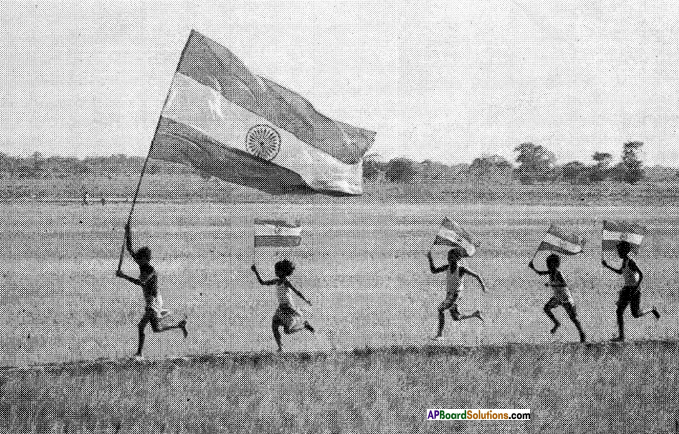
1) हिंद देश के निवासी,
सभी जन एक हैं।
रंग-रूप, वेश – भाषा
चाहे अनेक हैं ॥
2) बेला, गुलाब, जूही,
चंपा, चमेली।
प्यारे – प्यारे फूल गूंथे,
माला में एक हैं।
3. कोयल की कूक न्यारी,
पपीहे की टेर प्यारी।
गा रही तराना बुलबुल,
राग मगर एक है।।
4. गंगा, जमुना, ब्रह्मपुत्र,
कृष्णा, कावेरी॥
जाकर मिल गयीं सागर में,
हुई सब एक हैं।
![]()
बालगीत
चंदा मामा आओ ना
चंदा मामा आओ ना,
दूध बताशा खाओ ना,
मीठी लोरी गाओ ना,
बिस्तर में सो जाओ ना,
मीठी नींद सुलाओ ना
हाथी राजा
हाथी राजा बहुत बड़े,
सूंड उठा कर कहाँ चले।
मेरे घर में आओ ना,
हलवा पूडी खाओ ना।
आओ बैठो कुर्सी पर,
कुर्सी बोली चटर – पटर।
वीर तुम बढ़े चलो
वीर तुम बढ़े चलो ! धीर तुम बढे चलो !
हाथ में ध्वजा रहे बाल दल सजा रहे
ध्वज कभी झुके नहीं दल कभी रुके नहीं
वीर तुम बढ़े चलो ! धीर तुम बढ़े चलो !
सामने पहाड़ हों सिंह की दहाड़ हो
तुम निडर, डरो नहीं तुम निडर, डटो वहीं
वीर तुम बढ़े चलो! धीर तुम बढ़े चलो !
भारत माता
बोलो भारत माता की जय
आओ, सब मिलकर गायें
हम सब हैं आपस में बराबर
बोलो भारत माता की जय !
हम सब के सब भाई – भाई
हिंदु – मुस्लिम – सिख – ईसाई,
सबको अपना मित्र बनायें
बोलो भारत माता की जय !
